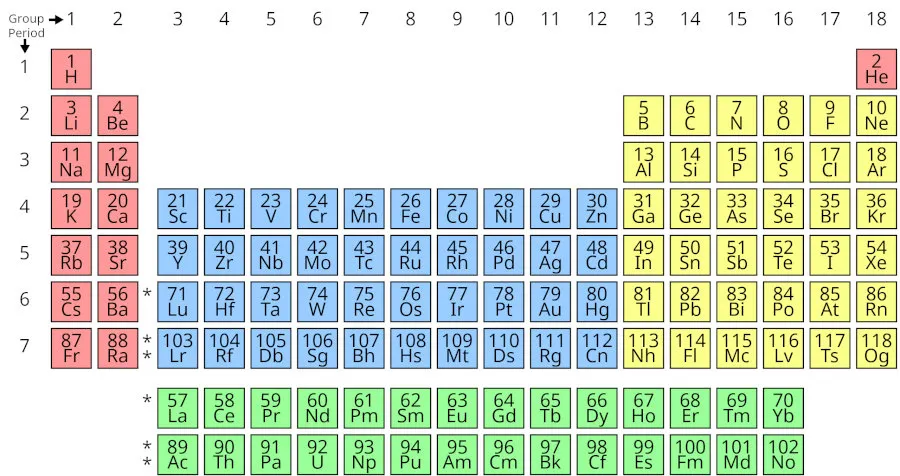We have all learned about the periodic table of chemical elements; it's that chart from chemistry class that I hated so much... Maybe that's because I hated chemistry class, and maybe that's because I couldn't get along with the teacher at all. I'm much older now, and I'd like to share with you my newfound appreciation for this wonderful tabular display of the chemical elements.

source: Wikipedia
When I was young I couldn't see how it was important to know about atoms, molecules, protons, electrons or atomic mass. I regret that now because I now know how the periodic table tells us something about the history of the universe and what we're made of. Stardust. That's what we're made of. Everything we know is made of atoms that were created inside stars. Most of us know what molecule we're mostly made of: water. So we generally think that the most common element inside our bodies is hydrogen; water is made of two hydrogen atoms and one oxygen atom after all. But here's where atomic mass starts playing a role in the story of everything; hydrogen has an atomic mass of 2, while oxygen has a mass of 16; if we go by mass, we're mostly made of oxygen!
The same goes for the room you're sitting in right now, assuming that the walls, floor and ceiling are made of concrete. Concrete is made of sand, which is made of silicon dioxide, one silicon atom weighing in at 28 and two oxygen atoms with a mass of 32. Oxygen, it turns out, is one of the most common elements, not only on our planet but in the entire universe. This goes for hydrogen and carbon as well; our planet and our bodies are made of the common stuff in the universe. We, going by mass, consist of 65% oxygen, 18.5% carbon, 9.5% hydrogen, 3.3% nitrogen, 1.5% calcium and 1% phosphorus, leaving 1.2% for all the other stuff like potassium, sulfur, sodium, chlorine and magnesium along with some trace elements.
Astronomers can tell what stars are made of by analyzing the light they emit, and it turns out they're made of 74% hydrogen and 25% helium, with everything else accounting for just 1%... Now, if you remember your periodic table, you'll know that hydrogen occupies the upper left corner with an atomic number of 1: it's the first element on the table. It's also the lightest element, with a core of just 1 proton and just 1 electron orbiting; hydrogen therefore has an atomic mass of 2. Helium is the next element with an atomic number of 2 and an atomic mass of 4, consisting of a core with two positively charged protons and 2 negatively charged electrons. Our sun is also made of hydrogen and helium. The wonderful thing is that these two elements aren't only the first on the periodic table, they're the first to ever have existed! The young universe, right after the Big Bang, only contained hydrogen, helium and some lithium. Lithium however, with atomic number 3, is a relatively unstable element and doesn't survive very long after it's created.
Heavier elements are created by crushing lighter elements together with high energy, temperatures and pressure; that's called nuclear fusion. These are the circumstances found inside the stars, and nuclear fusion is the process that creates heavier elements and produces the light without which we can not survive. And the bigger the star, the heavier elements it's capable of fusing. With this knowledge comes a mesmerizing realization; all the protons, electrons and neutrons that make up the atoms in our bodies we created 13.7 billion years ago! All the stuff that's in the universe right now, is the same stuff that was present right after its birth. At the time of the first stars, after gravity had clumped together huge masses of hydrogen and helium atoms, all the elements up to atomic number 8, oxygen, were made, which includes carbon as well; the basic components of organic life as we know it have been around nearly forever...
Although all this theory is kind of boring and dry, the kind of boring that couldn't hold my attention when I was young and in school, it now instills in me a feeling of wonder and oneness with everything. And everyone. I can't get over that miraculous feeling that the universe has created in us beings that are capable of examining itself, using the same basic components that make up itself and have been around since its birth. 13.7 billion year old sub-atomic elements are arranged in such a way that they can contemplate on where they came from... There's a whole lot more wonderful stuff to be understood with the periodic table as a starting point, so I'd like to take you all back to class with me in the below linked video. Just imagine you're back in school, but this time pay attention to what the teacher has to say... ;-)
The Origin of the Elements
Thanks so much for visiting my blog and reading my posts dear reader, I appreciate that a lot :-) If you like my content, please consider leaving a comment, upvote or resteem. I'll be back here tomorrow and sincerely hope you'll join me. Until then, stay safe, stay healthy!

Recent articles you might be interested in:
| Latest article >>>>>>>>>>> | Self-Help? |
|---|---|
| Manifest Nazism? | On Income Inequality |
| Buy, Borrow, Die Aristocracy | REVV Racing |
| Empire | Rise And Grind |

Thanks for stopping by and reading. If you really liked this content, if you disagree (or if you do agree), please leave a comment. Of course, upvotes, follows, resteems are all greatly appreciated, but nothing brings me and you more growth than sharing our ideas.